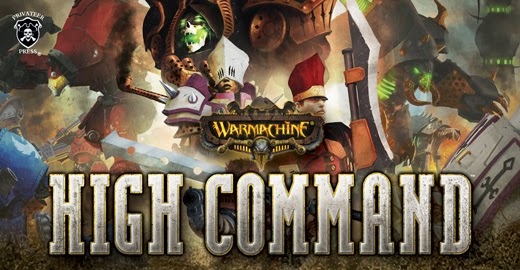Tactics: High Command – Victory Points and Captures

 |
| Courtesy of Privateer Press Digital. Used with Permission. |
High Command has markedly evolved over the past 12 months. Here is just a taste of how great it has become!
It is nearly an unrecognizable monster when judged in proximity to its humble beginnings. When the core sets were released, the external metagame consisted merely of selecting your detachments and accompanying warcasters/warlocks. The strongest combinations were quickly identified, and, had it been left unattended, High Command could have stagnated very quickly and been abandoned.
The first really important thing to understand with building your detachments and playing the game is the win condition, which is to have the most Victory Points when the Day of Reckoning card is flipped from the Winds of War deck. This effectively gives you between ten and fourteen turns to gain VPs through two means: purchasing or rushing cards from your reserves that have a VP value and capturing locations.
 |
| Courtesy of Privateer Press Digital. Used with Permission. |
Victory Points on detachment cards themselves make detachment construction somewhat of a balancing act, particularly where cards that are not worth any Victory Points are concerned. This makes serviceable cards that are worth two Victory Points fairly important and often extremely prevalent. Cards with great value that are also worth two Victory Points are consequently present in most any faction deck, with strong examples including the Feral Warpwolf, Cyclone, Behemoth, or a combination of Carniveans, Scytheans, or Ravogores depending on overall composition.
Cards that are worth a single Victory Point tend to make up the core of detachments since they are in greater abundance than their betters, starting most notably with the generic 4/4, 3/1, and 1/3 resource cards. Individual factions will have different flavors of single-VP cards here, especially so when theme is concerned. As someone who spends most of his time with Cygnar, Trencher Commandos, Hunters, and Storm Lances are among my favorites, but there are loads of viable options.
This leaves us with detachment cards without a Victory Point value. In my experience, these cards tend to make up the smallest percentage of my detachments since I typically want to be scoring Victory Points every turn, even if I cannot capture a location. For a card without a VP value to make it into a deck, it really has to bring something strong to the table. In some cases, these cards will often be the 3/3 Resource cards that provide 5/5 for Colossals or Battle Engines or the 2/2 Resource cards with faction-specific abilities. Non-resource cards are a little trickier, but common favorites for me seem to be Arcane Tempest Gun Mages, Journeyman Warcasters, and Trencher Heavy Artillery Teams.
 |
| Courtesy of Privateer Press Digital. Used with Permission. |
Now, the recommended minimum for your deck’s Victory Point count is going to vary widely depending on who you ask, and can also differ by faction choice. This is mostly due to the fact that High Command is a game that has only recently come into its own, and it lacks the huge online communities that you would find for other games, particularly for those with online play options that allow its denizens to distill the most optimal combinations down through the sheer brute force of mass volume of play. That said, I typically try to shoot for 36 Victory Points in my combined detachments. Since I have 36 cards in my detachments to customize, this means that the majority of the cards that I run will be worth at least 1 VP, and for every card that is worth 2 VP or more, it opens my build up to those non-scoring cards that I might otherwise avoid. Sometimes I am able to get well above 36 Victory Points, but it is not always the case.
It is also worth adding that the effects of the Location and Winds of War decks from Invasion of Sul are still being felt, one of them being a seeming impetus for running some of the really cheap, non-scoring rushing cards. The previews for Castle of the Keys have a similar tone about them, but only time will tell how this all shakes out.
The next thing that I feel is really important to the game is understanding when to let an opponent capture a location and when to contest the attempt. Making this type of decision depends on a lot of important factors:
- Has my opponent invested several cards with high purchase power and strong stats into the attempt?
- How many Victory Points is the location worth, what type of purchasing power does it have, and how will the location’s special ability play into the rest of the game?
- What are my current purchase/rush options in terms of Victory Points gained?
- What will it take to contest the location?
- How late into the game is it?
 |
| Courtesy of Privateer Press Digital. Used with Permission. |

